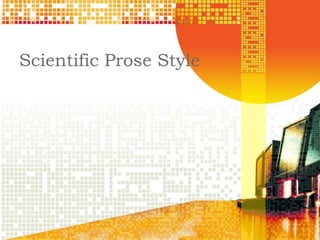
Scientific prose style
- 2. Plan • 1. The main functions of SPS • 2. The main characteristics of SPS • 3.The most frequent words used in scientific text • 4. The characteristic features of a sentence in SPS • 5. The constructions used in scientific prose style
- 3. The main function to provide factual and precise information, which must be clear, concise, unambiguous and explicit The target audience is a relatively small group of professionals who are well acquainted with the issue in question There is no space for any redundant, repetitive and unimportant information
- 4. The main Characteristics The tone formal, impersonal and objective Text is written in the third person Introduction/background, argument, conclusion and bibliography text is Text should be supported by references organized into chapters, sections and subsections
- 5. The first 100 most frequent words of this style Prepositions • of, to, in, for, with, on, at, by, from, out, about, down; Notional words people, time, two, like, man, made, years. Pronouns • one, it, we, they
- 6. Prepositional phrases • in terms of; in view of, in spite of, in common with, on behalf of, as a result of; by means of, on the ground of, in case of; Conjunctional phrases: • in order that, in case that, in spite of the fact that, on the ground that, for fear that;
- 7. The main purpose • A huge amount of connectors shows that the main purpose of the scientific prose texts is the logical sequence of utterances with clear indication of their interrelations and interdependence
- 8. Characteristic features of the sentence 1. 2. 3. • Mostly declarative sentences are used. • The simple sentence is longer than the main clause and the subordinate clause is the shortest one • It is also typical that the sentence consists of 4 clauses and more.
- 9. Some constructions used in the scientific texts Impersonal passive constructions • ‘it should be pointed out that…; it has been pointed out that…; it has previously been shown that….’ Causative constructions • ‘this makes the problem easy; this renders the metal hard; safety valves allow the metal to cool slowly’
- 10. Some constructions used in the scientific texts Formulas • ‘it is possible, necessary, essential to do sth; it is likely, evident, obviuos that; it is/has been/can be/will be/should be proved/shown/realized’ Connectors • ‘thus, however, therefore, furthermore, nevertheless, consequently…..; in fact, in short, in general, in this way, in other words’
- 11. Some constructions used in the scientific texts Subordinating conjunctions, referential pronouns, demonstrative pronouns /hierarchy/.
- 12. The scientific prose style contains both written and spoken utterances: Primarily written: • essays, articles, textbooks, scientific studies; Spoken: • presentations, discussions, conferences Monologue: • no feedback, no situational context, no paralinguistic features.
- 13. Conclusion • 1. Never use a metaphor, simile, or other figure of speech which you are used to seeing in print. • 2. Never use a long word where a short one will do. • 3. If it is possible to cut a word out, always cut it out.
- 14. • 4. Never use the passive where you can use the active. • 5. Never use a foreign phrase, a scientific word, or a jargon word if you can think of an everyday English equivalent. • 6. Break any of these rules sooner than say anything outright barbarous
- 15. References • Biber, D. et al. (1999). Longman grammar of spoken and written English.Harrow: Longman. • Carol, S. & Gregory, M. (1978). Language varieties and their social contexts. London: Routledge & Kegan Paul. • Goumovskaya, G. Scientific prose style. Retrieved April7, 2012, from http://eng.1september.ru/2007/16/8.html. • Halliday, M. A. K., McIntosh, A. & Strevens, P. (1964). The lingustic sciences and language teaching. London: Longman
